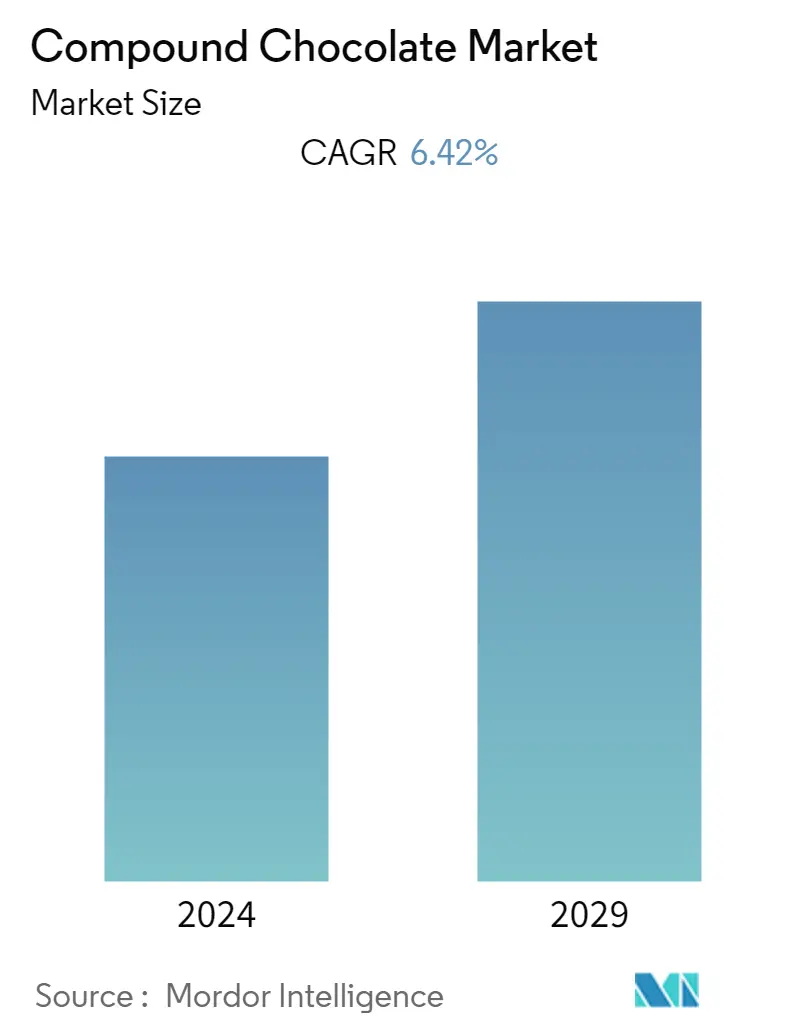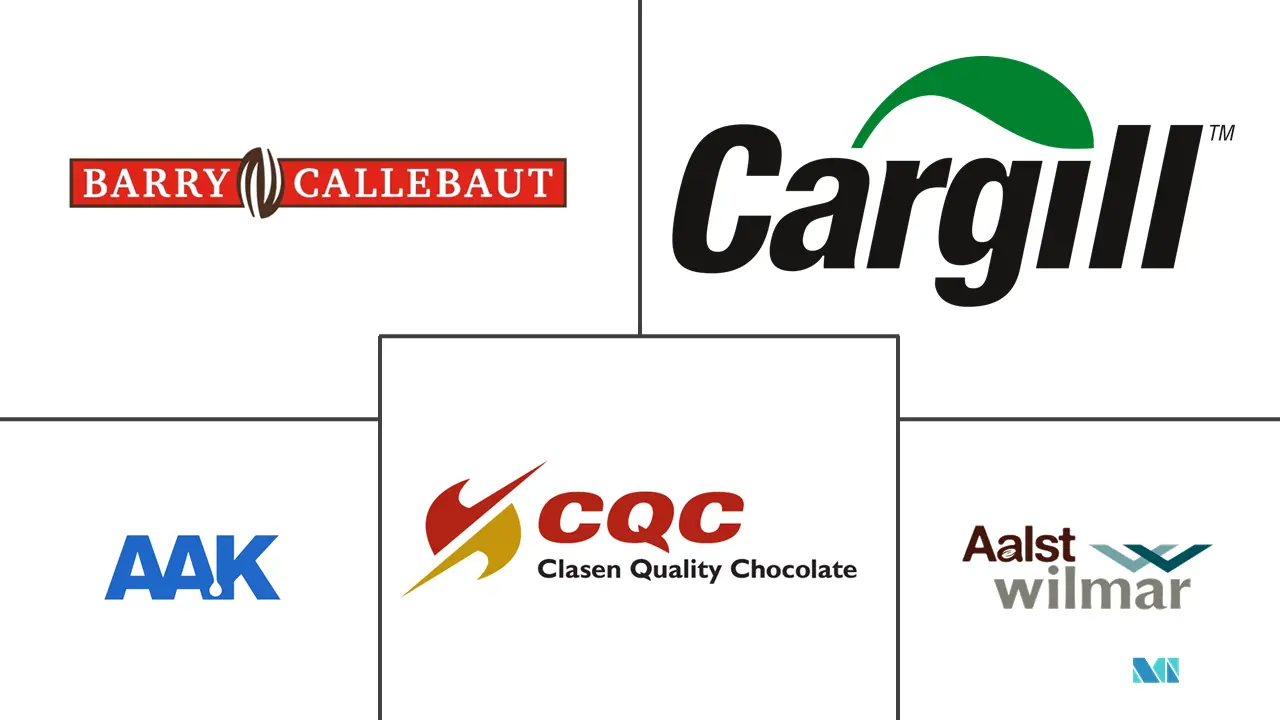Market Size of Compound Chocolate Industry

| Study Period | 2019 - 2029 |
| Base Year For Estimation | 2023 |
| CAGR | 6.42 % |
| Fastest Growing Market | Asia Pacific |
| Largest Market | Europe |
| Market Concentration | Low |
Major Players
*Disclaimer: Major Players sorted in no particular order |
Compound Chocolate Market Analysis
The compound chocolate market is expected to register a CAGR of 6.42% during the forecast period (2022-2027).
The COVID-19 outbreak and supply-side issues linked to quality and certification impacted the chocolate market's sales. With the impact of COVID-19, mainstream consumption of compound chocolate at the retail and industrial levels seemed stable. However, the craft chocolate segment is facing difficulties. The market is observing demand for healthy ingredients, which opens an opportunity for better-for-you chocolates at the retail and application levels.
A primary factor driving the market for compound chocolate is its functionality at a lower price, which is boosting its demand. Its functional attributes allow it to be converted as a replica of coverture or real chocolate at a lower price than coverture chocolate.
Moreover, compound chocolate contains hard fat, making it suitable for products such as granola bars and trail mixes, where baking at higher temperatures is required. The composition of compound chocolate also helps increase the product's shelf life. Companies are coming up with sustainable solutions for sourcing and the usage of cocoa butter substitutes or cocoa butter equivalents in products.
Compound Chocolate Industry Segmentation
Compound chocolates are cocoa products containing cocoa butter substitutes (CBS) or cocoa butter equivalent (CBE). The vegetable fats commonly used are often hard fats or semi-solid fats at room temperatures, such as coconut oil and palm kernel oil. The compound chocolate market is segmented into type, form, application, and geography. The report offers the market size and forecast in value (USD million) for all the above segments.
| By Type | |
| Dark | |
| Milk | |
| White |
| By Form | |
| Chocolate Chips/Drops/Chunks | |
| Chocolate Slab | |
| Chocolate Coatings | |
| Other Forms |
| By Application | |
| Bakery | |
| Confectionery | |
| Frozen Desserts and Ice Cream | |
| Beverages | |
| Cereals | |
| Other Applications |
| By Geography | |||||||||
| |||||||||
| |||||||||
| |||||||||
| |||||||||
|
Compound Chocolate Market Size Summary
The compound chocolate market is experiencing a steady growth trajectory, driven by its cost-effective functionality and versatility in various applications. The market has shown resilience despite challenges posed by the COVID-19 pandemic, with stable demand at both retail and industrial levels. The appeal of compound chocolate lies in its ability to mimic the qualities of real chocolate at a lower price point, making it an attractive option for manufacturers. Its composition, which includes hard fat, enhances its suitability for products requiring high-temperature baking, such as granola bars and trail mixes, while also extending shelf life. The market is witnessing a shift towards healthier ingredients, creating opportunities for better-for-you chocolate options. Companies are increasingly focusing on sustainable sourcing and the use of cocoa butter substitutes to meet the growing demand for premium and exclusive products, particularly in regions like Europe and North America.
In North America, the demand for compound chocolate is anticipated to rise, fueled by the growing interest in premium chocolate and confectionery items. The market is characterized by a diverse range of players, with major companies like Cargill Incorporated, AAK, Barry Callebaut, and Clasen Quality Chocolate Inc. leading the charge in innovation and research. These companies are investing in the development of better cocoa butter substitutes and equivalents to enhance the health aspects of their products. The compound chocolate market is also seeing increased activity around special occasions, with manufacturers offering themed products in various colors and shapes. Recent product launches, such as Mondelez International's Oreo frozen desserts and Barry Callebaut's dairy-free chocolate compound, highlight the ongoing innovation and expansion within the market. As manufacturing methods and flavors continue to improve, compound chocolate is poised to become an even more desirable choice for food manufacturers across different segments.
Compound Chocolate Market Size - Table of Contents
-
1. MARKET DYNAMICS
-
1.1 Market Drivers
-
1.2 Market Restraints
-
1.3 Porter's Five Forces Analysis
-
1.3.1 Threat of New Entrants
-
1.3.2 Bargaining Power of Buyers/Consumers
-
1.3.3 Bargaining Power of Suppliers
-
1.3.4 Threat of Substitute Products
-
1.3.5 Intensity of Competitive Rivalry
-
-
-
2. MARKET SEGMENTATION
-
2.1 By Type
-
2.1.1 Dark
-
2.1.2 Milk
-
2.1.3 White
-
-
2.2 By Form
-
2.2.1 Chocolate Chips/Drops/Chunks
-
2.2.2 Chocolate Slab
-
2.2.3 Chocolate Coatings
-
2.2.4 Other Forms
-
-
2.3 By Application
-
2.3.1 Bakery
-
2.3.2 Confectionery
-
2.3.3 Frozen Desserts and Ice Cream
-
2.3.4 Beverages
-
2.3.5 Cereals
-
2.3.6 Other Applications
-
-
2.4 By Geography
-
2.4.1 North America
-
2.4.1.1 United States
-
2.4.1.2 Canada
-
2.4.1.3 Mexico
-
2.4.1.4 Rest of North America
-
-
2.4.2 Europe
-
2.4.2.1 Spain
-
2.4.2.2 United Kingdom
-
2.4.2.3 Germany
-
2.4.2.4 France
-
2.4.2.5 Italy
-
2.4.2.6 Russia
-
2.4.2.7 Rest of Europe
-
-
2.4.3 Asia-Pacific
-
2.4.3.1 China
-
2.4.3.2 Japan
-
2.4.3.3 India
-
2.4.3.4 Australia
-
2.4.3.5 Rest of Asia-Pacific
-
-
2.4.4 South America
-
2.4.4.1 Brazil
-
2.4.4.2 Argentina
-
2.4.4.3 Rest of South America
-
-
2.4.5 Middle-East and Africa
-
2.4.5.1 South Africa
-
2.4.5.2 United Arab Emirates
-
2.4.5.3 Rest of Middle-East and Africa
-
-
-
Compound Chocolate Market Size FAQs
What is the current Compound Chocolate Market size?
The Compound Chocolate Market is projected to register a CAGR of 6.42% during the forecast period (2024-2029)
Who are the key players in Compound Chocolate Market?
Barry Callebaut, Aalst Wilmar Pte Ltd, AAK, Cargill Incorporated and Clasen Quality Coatings Inc. are the major companies operating in the Compound Chocolate Market.

